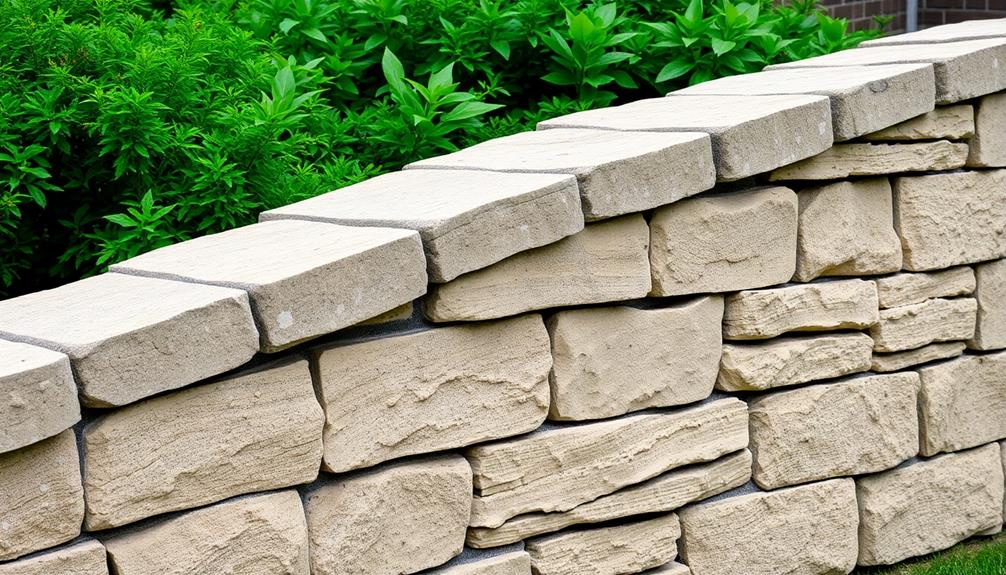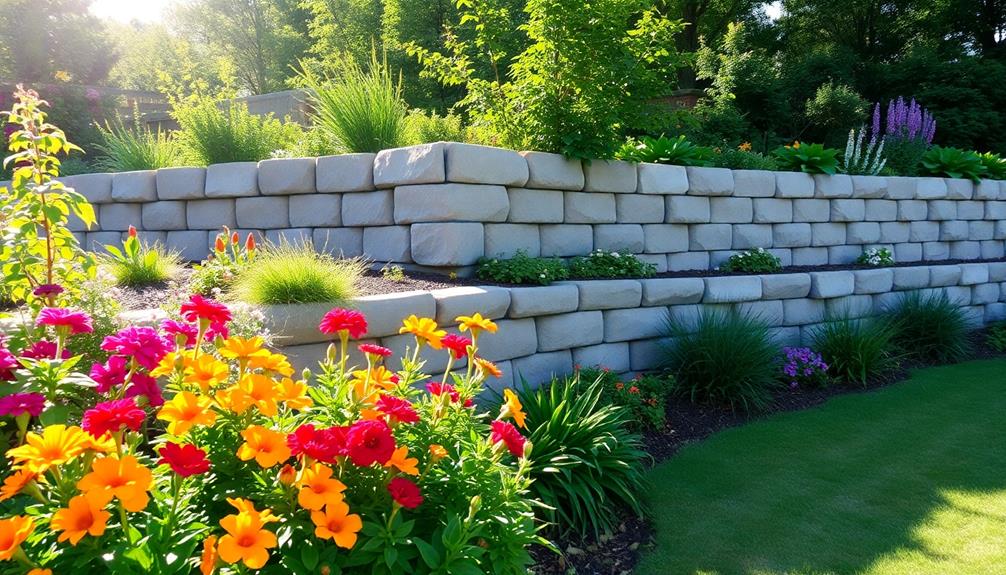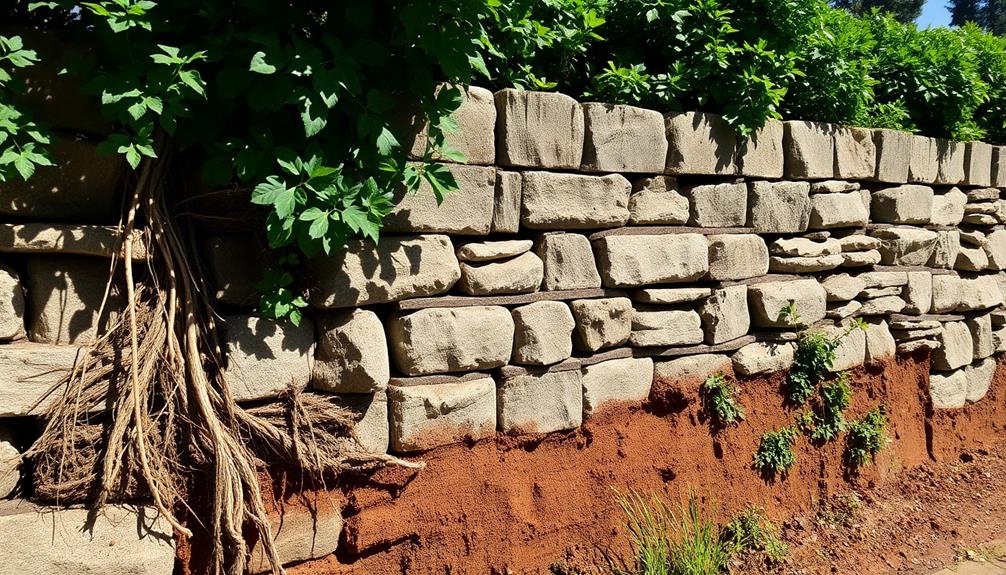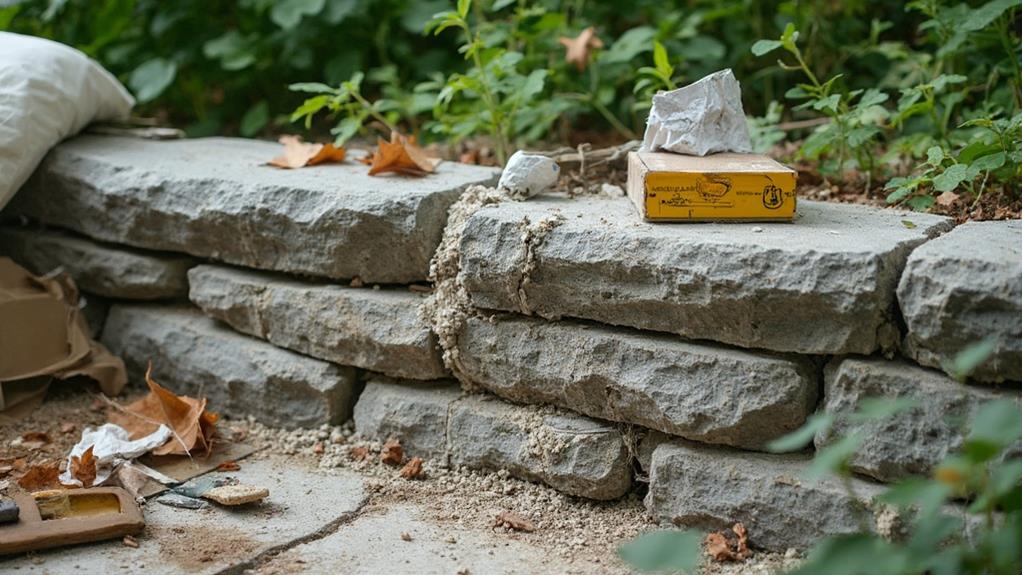Repairing a leaning retaining wall requires a thorough assessment to identify structural deficiencies and the underlying causes such as soil erosion or poor drainage. Consulting with structural engineers is essential to obtain permits and formulate a detailed repair plan. The restoration process involves excavating the foundation, reinforcing it with techniques like additional concrete footings or geogrid, and enhancing drainage systems to reduce water pressure. Completing the repairs involves reconstructing the wall to correct alignment and stability, followed by cosmetic touches like adding sealants or landscaping elements. Exploring the advantages of these methods could vastly improve wall lifespan and property value.
Table of Contents
ToggleWalls Contractor Highlights
- Assess the wall's degree of lean and underlying structural issues, including soil erosion and poor drainage.
- Consult with structural engineers to develop a comprehensive repair plan tailored to the wall's condition.
- Excavate the wall's foundation, reinforce it using concrete or footings, and incorporate reinforcement techniques like geogrids or anchors.
- Improve drainage systems to manage water pressure and prevent future structural damage.
- Rebuild the wall ensuring alignment and stability, and conduct inspections to confirm successful repairs.
Definition of Retaining Wall

A retaining wall, primarily designed for the vital purpose of holding back soil and preventing erosion, serves both functional and aesthetic roles in landscaping and construction. Retaining walls like those built by Granite Company not only guarantee stability but also offer solutions for shoreline restoration and erosion control.
There are multiple types of retaining walls such as gravity, cantilever, and anchored, each tailored to specific site conditions and requirements, while encompassing a range of materials from concrete to timber. Understanding the structural components, which include the footing, drainage systems, and reinforcement elements, is indispensable for comprehending how these walls guarantee stability and durability in various environments.
Purpose and Functionality
Stability is the essence of a retaining wall's purpose and functionality. These structures are critical for ensuring that soil remains in place, thereby preventing erosion and landslides. Serving as a steadfast barrier between different elevations, retaining walls support the structural integrity of landscapes, often transforming challenging terrains into usable spaces.
Their design and construction are pivotal in managing the lateral pressure exerted by soil, which is essential in areas susceptible to shifting ground. This prevention of soil movement safeguards properties, paths, and infrastructures, creating a sense of reliability and trust in the built environment.
Beyond their structural role, retaining walls contribute aesthetically, enhancing outdoor environments and providing definition to spaces. They help delineate gardens, yards, and pedestrian zones, blending functionality with design. With the ability to integrate various materials such as stone, concrete, and timber, they offer flexibility in style while optimizing land use and increasing property value.
For communities, both residential and commercial, these walls provide reassurance in the stability of their surroundings. In this way, retaining walls serve as a foundation for safety and order, reflecting our collective desire for control over our environments, promoting a sense of belonging and security within our shared landscapes.
Types of Retaining Walls
In recognizing the essential role retaining walls play in stabilizing landscapes, it is important to understand the various types of retaining walls and their unique functions. Retaining walls, integral components of many terrain management projects, serve both functional and aesthetic purposes, all while providing the necessary support to counteract the lateral pressure of soil. These structures are categorized mainly into four types: gravity walls, cantilevered walls, anchored walls, and sheet piling walls, each boasting distinct attributes suitable for specific environmental conditions and structural requirements.
Gravity retaining walls rely on their immense mass and weight to resist the lateral pressure of the earth behind them, often constructed with concrete, stone, or brick. Cantilevered walls, on the other hand, utilize reinforced concrete or steel beams projecting into the soil to transform horizontal earth pressures into vertical loads on the footing. Anchored walls, suitable for challenging terrains, are reinforced with cables or anchors within the surrounding rock or soil, providing additional support to enhance wall stability. Finally, sheet piling walls, prevalent in softer soils and constrained spaces, are built by driving slender steel or vinyl sheets deep into the ground, offering a reliable boundary against the forces exerted by fluid or loose masses.
Structural Components Overview
Many retaining walls comprise intricate structural components, each meticulously designed to maintain stability and durability under varying conditions. At their core, retaining walls are engineered to hold back soil and prevent erosion, especially in terrains with embankments or slopes. A well-constructed wall not only provides functional support but also integrates harmoniously with the landscape, reinforcing the owner's place within their environment.
The primary components of a retaining wall include the foundation footing, drainage system, reinforcement, and the facing materials. The foundation, often made of poured concrete, serves as the bedrock of the structure, ensuring that the wall remains anchored under immense weight. Drainage is critical to preventing water buildup and pressure, typically managed through weep holes or gravel backfill. Reinforcement, whether through steel bars or geogrid materials, enhances the wall's integrity against lateral earth pressures.
Various materials such as stone, concrete blocks, or timber provide the aesthetic facing of the wall, each offering distinct benefits and appearances. These components work in unison, creating a cohesive structure poised to withstand nature's forces. Understanding these elements fosters a deeper appreciation and connection, allowing property owners to confidently address any need for repair or enhancement in their retaining walls.
Benefits

Repairing a leaning retaining wall offers significant benefits that enhance both the functionality and appearance of a property. By addressing issues related to a compromised wall, the structural integrity of the landscape is fortified, safeguarding against potential collapses and further damage.
Whether it's a concrete retaining wall or a stone retaining wall, expert repair services utilize specialized tools and techniques to effectively restore these structures. Additionally, rectifying the wall not only improves the aesthetic appeal but also contributes to an increased property value, making the investment in repairs financially advantageous.
Enhanced Structural Integrity
Achieving enhanced structural integrity in a retaining wall offers significant benefits, primarily ensuring the long-term stability and safety of the structure. This improvement diminishes the risk of wall failure, thereby protecting adjacent landscapes, properties, and infrastructure from potential damage. Enhanced structural integrity is achieved through meticulous engineering practices that involve reinforcing weakened areas, potentially integrating geogrid materials for additional support, and utilizing appropriate drainage systems to mitigate hydrostatic pressure. By fortifying these elements, retaining walls can effectively sustain the loads imposed by the retained material and environmental stressors such as heavy rainfall or seismic activity.
Moreover, the assurance of structural soundness nurtures a sense of security within communities, fostering belonging and pride among residents and stakeholders. A well-maintained and structurally sound wall demonstrates a commitment to safety, quality, and community welfare, which are integral components of shared societal values. Additionally, such improvements may positively influence property values, thereby contributing to the economic importance of the area. When retaining walls are constructed or repaired with enhanced structural cohesion, they symbolize resilience and thoughtful planning, reinforcing a community's collective spirit and shared dedication to creating a durable and harmonious living environment.
Improved Aesthetic Appeal
While structural integrity is fundamental to the longevity and safety of retaining walls, the visual appeal of these structures also holds considerable significance. A well-maintained retaining wall not only serves a functional purpose but also complements the aesthetic essence of the surrounding landscape.
Engaging in professional repairs of a leaning retaining wall transforms it from merely a utility fixture into a striking feature, enhancing the visual harmony of your property. The seamless integration of repaired or redesigned walls with garden elements creates a cohesive appearance, fostering a sense of unity and belonging within the environment.
Maintaining or improving the aesthetic allure of retaining walls through repairs or strategic upgrades may involve selecting materials that blend naturally with their surroundings, thereby enhancing the visual depth and texture. Opting for design elements that reflect contemporary trends or personal preferences can inject a sense of identity and creativity into outdoor spaces.
Adding decorative features or innovative lighting solutions can also imbue the area with charm and character, cultivating a welcoming atmosphere for family and guests alike. Ultimately, these efforts solidify the repaired retaining wall as a centerpiece of outdoor living spaces, showcasing meticulous care and thoughtful design.
Increased Property Value
Enhancing the structural integrity and visual appeal of a retaining wall can markedly boost a property's market value. This improvement enhances not only the functionality of the land but also its overall aesthetic, creating an inviting environment that appeals to potential buyers. A well-maintained retaining wall implies attentive property management, reassuring prospective investors and residents of the care invested in the site's upkeep. This perception of responsible stewardship can add a layer of desirability, potentially increasing competitive market interest.
Moreover, the restoration of a leaning retaining wall reinforces essential land stability, safeguarding valuable landscape features such as gardens, terraces, and driveways. These elements can become tangible selling points, differentiating the property with respect to usability and enhancement possibilities. Properly repaired walls can support diversified landscaping which, in turn, can lead to further property magnetism by showcasing versatile outdoor spaces.
With regards to investment, a repaired wall minimizes the risk of sudden structural failures that could lead to costly damage. By preemptively addressing these concerns, property owners contribute to maintaining or even enhancing the worth of their real estate assets, solidifying their place within the competitive property market where attractiveness and reliability are critical to valuation.
Prevention of Further Damage
Preventing further damage to a leaning retaining wall not only safeguards the immediate structural integrity but also guarantees the long-term durability of the surrounding environment. A thorough approach to prevention involves identifying and mitigating potential factors that may exacerbate the wall's condition. By addressing issues such as inadequate drainage, soil erosion, or improper construction techniques, homeowners and property managers can make certain their investment remains stable.
Advanced reinforcement methods, such as installing tiebacks or anchors, can provide additional support to the wall, effectively halting further tilting. Implementing these preventive measures fosters a sense of security and communal responsibility, as these actions contribute to maintaining the aesthetic and safety of the shared environment for future generations.
Moreover, routine inspections and maintenance play a pivotal role in the prevention strategy. Engaging professionals for periodic evaluations makes certain that any signs of distress are promptly addressed before they escalate. Maintaining effective drainage systems to divert water away from the wall, alongside reducing surface runoff, minimizes the risk of water-related damage, one of the primary causes of leaning. An active commitment to prevention not only strengthens the wall but also reinforces the universal value of proactive care within the community.
Causes of Wall Leaning

When addressing the problem of leaning retaining walls, it is critical to understand the underlying causes, which commonly include soil erosion effects, inadequate drainage solutions, and structural design flaws. Each of these factors can contribute to destabilizing a retaining wall, ultimately compromising its integrity and effectiveness. The following table succinctly outlines these key causes, highlighting their impact on wall stability:
| Cause | Description | Impact on Wall Stability |
|---|---|---|
| Soil Erosion | Loss of ground support due to water runoff and weathering | Weakens the base, causing tilting |
| Poor Drainage Solutions | Accumulation of water exerting pressure on the wall | Increases soil pressure, leading to leaning |
| Structural Design Flaws | Faulty engineering or construction practices | Lacks proper load distribution |
Understanding these causes is an essential step towards implementing effective corrective measures.
Soil Erosion Effect
Soil erosion stands as a primary culprit in the leaning of retaining walls. This natural process can undermine the foundational stability of these structures, leading to significant tilting and eventual failure. As soil particles are displaced by water, wind, or other forces, they diminish the support originally provided to the wall, causing it to lean. Soil erosion's adverse effects can be exacerbated when coupled with other environmental factors, necessitating timely interventions. Understanding the mechanisms by which soil erosion impacts retaining walls can foster a sense of belonging to a well-informed community dedicated to preserving structural integrity.
To extensively address the issue, several factors must be examined:
- Water Flow: Consistent water flow through or around a retaining wall can erode soil quickly, weakening its structural basis and causing misalignment or leaning.
- Slope Gradient: The angle of the slope behind a retaining wall can amplify erosion, allowing more material to be removed over time, compromising stability.
- Vegetation Absence: A lack of plants contributes to erosion, as plant roots provide essential hold for soil particles, preventing displacement.
- Human Activity: Construction and landscaping activities can inadvertently increase erosion by altering drainage patterns, highlighting the importance of careful planning.
Poor Drainage Solutions
Effective drainage systems are essential for the stability of retaining walls, and deficiencies in these systems are a significant cause of wall leaning. When water accumulates behind a retaining wall due to poor drainage, it increases the hydrostatic pressure exerted on the structure. This pressure can gradually exacerbate the strain on the wall, leading to imperfections and eventual leaning. The integration of adequate drainage solutions, such as weep holes or perforated pipes, effectively directs water away, reducing pressure and maintaining the wall's integrity.
Inadequate drainage often results from a lack of foresight during the planning stage, where the absence of appropriate water management strategies goes unnoticed. Additionally, natural events, such as heavy rainfall or rapid snowmelt, can overwhelm existing drainage systems, if they are not designed to accommodate extreme weather conditions.
Over time, debris and sediment can also clog drainage paths, rendering them ineffective and inadvertently contributing to the destabilization of the wall.
Retaining walls are fundamental components in landscaping and construction, shaping safe and visually appealing environments. The inclusion of robust drainage solutions within their design not only guarantees structural stability but also engenders a sense of security and community among those who inhabit the surrounding space.
Structural Design Flaws
Addressing structural design flaws in retaining walls is essential for preventing leaning and ensuring long-term stability. Such flaws often arise from inadequate initial planning or a misunderstanding of the fundamental principles governing wall construction. These imperfections can lead to costly repairs and compromise the wall's integrity.
Understanding these structural missteps empowers builders and homeowners to adopt effective preventative measures that foster community resilience and trust. Below are key structural design flaws that may contribute to a leaning retaining wall:
- Insufficient Foundation: A poorly designed foundation can fail to adequately support the weight of the wall and the retained soil, leading to gradual movement and eventual leaning.
- Inadequate Reinforcement: Skimping on necessary reinforcing materials, like steel bars or geogrid, reduces the wall's capacity to withstand lateral earth pressures over time.
- Incorrect Wall Dimensions: Walls that are too thin or have improper height-to-thickness ratios may lack the stability needed to resist soil pressure effectively.
- Faulty Backfill Compaction: If the soil behind the wall is not compacted correctly, it can lead to uneven pressure distribution, causing shifts that push the wall outward.
Walls Contractor FAQ
What Tools Are Needed to Repair a Leaning Retaining Wall?
Addressing structural issues requires essential tools such as a level, shovel, wrenches, masonry drill, and wheelbarrow. These facilitate precise adjustments, helping to safeguard the wall's stability and longevity, fostering confidence and competence in your abilities.
How Much Does It Cost to Fix a Leaning Retaining Wall?
The cost to rectify structural misalignments varies considerably based on material, extent of lean, and geographic location. On average, expenses range from $200 to $1,500. Consulting a professional guarantees community standards and safety regulations are met.
Can a DIY Repair Be Effective for a Leaning Retaining Wall?
A DIY repair for a leaning structure can be effective if one possesses the right skills, tools, and knowledge. For community safety and longevity, consulting with professionals guarantees compliance with engineering standards and fosters collective responsibility.
When Should You Call a Professional to Fix a Leaning Retaining Wall?
You should contact a professional when the wall shows significant damage, threatens structural integrity, or when initial DIY efforts fail. This guarantees expertise, safety, and community confidence in maintaining our shared environment's stability and aesthetic appeal.
What Materials Are Best for Reinforcing a Leaning Retaining Wall?
For reinforcing purposes, materials such as steel rebars, geogrids, or helical tiebacks are highly effective. Their strength and durability guarantee the stability of structures, fostering confidence and a sense of safety within community infrastructure networks.







